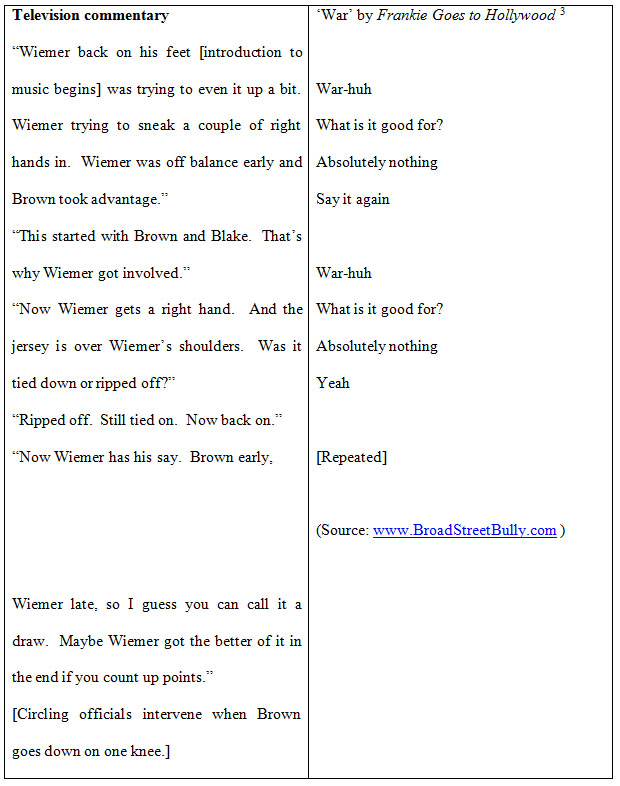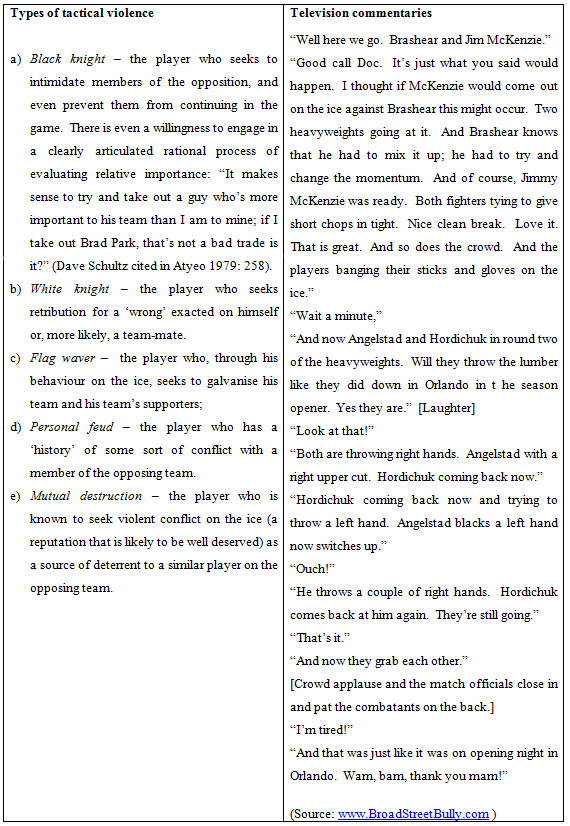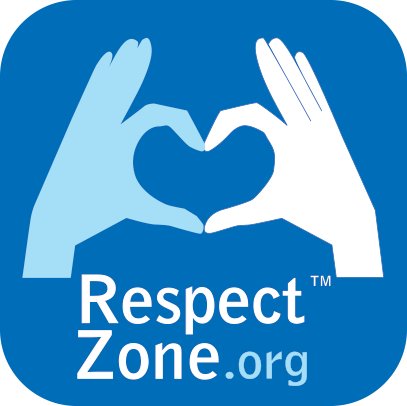Article
| 5 - Towards a theoretical understanding of violence in ice hockey by Scott Fleming, University of Wales Institute Cardiff, CF23 6XD Theme : International Journal on Violence and School, n°6, November 2008 |
| Ice hockey is characterised by high levels of skill and aggressive (often violent) confrontation. In this short paper, discourses surrounding on-ice violence in ice hockey are explored through ethical/sociological lenses. Based on empirical examples to illustrate the theoretical distinctions, a preliminary typology of on-ice incidents that may be described as violent rule-violations illuminates the analysis. There are (at least) three forms of violent conduct that can be differentiated and are accepted within the ethos (after Bourdieu, 1993) of elite level ice hockey – tactical, symbolic and actual. There is a fourth that is not tolerated. |
Keywords : Ice-hockey, Violence, Ethos.
| PDF file here.
Click on the title to see the text. INTRODUCTION Ice hockey (hereafter referred to as hockey) is characterised by high levels of skill and aggressive (often violent) confrontation. According to Gruneau and Whitson (1993) it is often an expression of working-class masculinity. In this short paper, I develop some preliminary work (Fleming 2005) and explore some of the discourses surrounding hockey. In particular, I focus on aspects of on-ice violence. I do this from the perspective of a cultural (British) outsider, though also through the lens of a sociologist with a professional interest in the application of ethics to sport and leisure . The style is deliberately polemical with the intention of stimulating discussion. The violence associated with hockey is so embedded that it has entered many forms of popular culture. There is ‘literature’ – for example Fischler’s (1999) The Ultimate Bad Boys and Allen’s (1999) Crunch – big hitters, shot blockers and bone crushers; there are movies – for example, Slap Shot and Slap Shot II – Breaking the Ice; and there are websites dedicated to show-casing on-ice violence – for example, www.BroadStreetBully.com and . All of this, and there is much more besides, indicates a market for the consumption of hockey-related violence. A (MINOR) MORAL PANIC? The intention of this paper is not to criticise hockey and those involved with it (in whatever capacity) per se. Rather, it is to situate the centrality of perceptions of violence within appropriately informed cultural contexts. Violence in hockey is not a new phenomenon. Angela Patmore (1986) has described its escalation during the late 1960s and early 1970s, and the sense of active encouragement for it that seemed prevalent at that time. In a nationwide survey in 1970, 40% of all respondents reported that they liked to see violence in hockey. There is more recent evidence of hockey’s popularity rising as the level of aggression has been raised (DeNeui & Scahau, 1993). It would be naïve and simplistic, therefore, to identify the violence in hockey and seek an ethically informed interpretation of the game that was not sensitive to the prevailing circumstances. The various interested parties in the game form a community of stake-holders, and different constituencies propagate violence in different ways. In addition to those identified above, two of the clearest can be witnessed on big game night. At the rink, the first signs of an altercation between players (usually the point at which they ‘square up’ to each other) may be greeted with some suitably provocative and pulsating loud music played over the public address system. The commentators then describe the action. Far from receiving approbation for rule-violations and the violence that ensues, the players involved have their pugilistic skills evaluated as if they were boxing for a world title at Madison Square Garden. Inevitably, written text does not convey the full richness of the scenario, but one example does draw attention to the juxtaposition of the commentators’ account and the music: 
Yet in spite of the relish with which the voyeuristic spectator enjoys witnessing apparent on-ice brutality, there is an emerging tension amongst different groups of the game’s stake-holders towards its violent character. There is a strong lobbying group that seeks to increase player safety and to reduce risk of injury. This has been led by the intervention of the medical profession (e.g., Roberts, 1999; American Academy of Pediatrics, 2000; Marchie & Cusimano, 2003; Montelpare et al., 2003), and some of the rhetoric now bears the hallmarks of a minor ‘moral panic’ (cf. Cohen, 1987). There have also been directives to match officials about the particularly violent and dangerous practice of ‘head-checking’. AN EMERGING TYPOLOGY OF VIOLENCE IN HOCKEY A preliminary typology of the kinds of on-ice incidents that may be described as violent rule-violations sheds light on this debate (see Figure 1). There are (at least) three forms of violent conduct that can be differentiated and are tolerated within the ethos (after Bourdieu, 1993) of elite level hockey – tactical, symbolic and actual. There is a fourth that is not tolerated. Brief elaboration of each serves to clarify the distinctions, and the media treatment of key episodes will illuminate further. 
Figure 1 Understanding Hockey Violence TACTICAL VIOLENCE There are a number of different reasons that might lead to on-ice violence that have their origins in the perceptions that are held about their instrumental value. That is to say, players and coaches may employ violent conduct because they believe that in doing so, their chances of achieving overall outcome success are enhanced. Atyeo’s (1979) rather crude (and now dated) instantiation of the principle, whilst unsophisticated, is illustrative. He refers to the tactical use of violence as “a new martial art: premeditated violence… strike only when behind and always at the star” (p.256). With a similar lack of refinement he also cites Shero (1975): “If you keep the opposition on their butts they don’t score goals” (Atyeo 1979: 257). Allen’s (1999) account of tactical violence is more context-sensitive and hence more compelling. His rhetorical style is also more vivid. He locates a sub-typology of tactical interventions: 
Figure 1 Understanding Hockey Violence SYMBOLIC VIOLENCE This form of violent conduct within the context of the game draws its theoretical exposition from the work of Marsh et al. (1978), amongst others, about manifestations of ritualised aggression as culturally patterned behaviour. A somewhat simplified account of their analysis is that the apparently chaotic and unplanned scenes associated with sport-related disorder are often actually conforming to the (unwritten) rules of disorder. Inevitably, of course, this analysis was subjected to stern critique as it did not accommodate satisfactorily those instances when real physical and psychological harms ensued. Nevertheless, this conceptualisation of violent behaviour as being associated more with the performance and spectacle of aggressive conduct than with the actual consequences of violence has some application for hockey – if only as part of a larger theoretical framework. 
ACTUAL VIOLENCE The critique of the symbolic (ritualised) account of hockey violence rests, to a significant extent, on the evidence of actual violence that occurs. In short, violence can not be merely symbolic of players really get hurt. Some of this may be a result of a failure to recognise the cues and signals from an opponent in the tacitly agreed ritual combat that occurs. It may also be a result of a lack of competence and/or sophistication in ‘acting out’ the role. But whatever the reason, there can be no disguising the real harm(s) that can accrue. One brief episode in which one player administered a ‘king hit’ to an opponent was described by a commentator in the following way: We had a fight: Jesse Boulerice – Aaron Downey. Boulerice, in the red, misses. Downey hits. Like my grandpa used to say: ‘there’ll be two hits, I hit you, you hit the floor’. That’s what happened if we take another look. Boom, good night. (Source: www.BroadStreetBully.com ) VIOLENCE THAT IS UNACCEPTABLE TO THE ETHOS The three preceding types of violence are accepted within hockey. They also represent something of a paradox. For whilst the actions are, de jure, violations of the game’s constitutive and regulative rules, they have also, de facto, become normalised and legitimised within the social fabric of the game (Colburn, 1986). They are contests within the game itself and even display some virtues of ‘fair play’: (in the main) they are well matched combatants, they demonstrate endeavour, and there is evidence of some respect for opponents. The final type of violence, however, does none of these. The clearest recent illustration of violence that is unacceptable to the ethos of hockey was the well-documented assault by Marty McSorley on Donald Brashear. The match-night commentary was descriptive and non-judgmental: “Watch Marty McSorley, two-fisted chop right on the side of the head of Brashear who goes down and bangs his head on the ice. After that the entire Vancouver team attack McSorley. Brashear carried off on a stretcher with a neck brace.” [emphasis added] A separate news item, this time a retrospective account, was more graphic and detailed: Boston Bruins forward Marty McSorley has been hit with what could turn out to be the longest ban in National Hockey League history for on-ice violence. McSorley attacked Vancouver Canucks star Donald Brashear from behind in his side's 5-2 defeat on Monday, striking him across the right temple with a two-handed swinging slash with his stick. Brashear fell backwards, his head hitting the ice and with blood pouring from his nose before being stretchered off and diagnosed with concussion, which could leave him sidelined for up to three weeks. The NHL reacted swiftly and have banned McSorley for the remainder of the season - at least 23 matches if Boston reach the play-offs…NHL vice-president and director of hockey operations Colin Campbell said, “This incident is not indicative of how ice hockey is played or how it should be played. I have been involved in a lot of hockey games myself in 30 years and I have never seen a player strike another player like that from behind. McSorley's act is entirely unacceptable. It would be grossly unfair to suggest that his conduct is at all representative of the game, of the other 700 players who play in the NHL or of the countless others who play hockey at all levels. We regret that this act occurred and that is has brought this kind of attention to our game.” [emphasis added] There are five points to emerge from these reports. First, the incident itself, a cowardly act that has contravened the established (but unwritten) protocol for acceptable on-ice violence . Second, the immediate demonstration of disapproval and approbation from all of Brashear’s team-mates; violence begetting more violence. Third, the sanction imposed by the National Governing Body – amongst the most severe of its kind . Fourth, the unambiguous and forthright condemnation of the act by a senior institutional figure. Fifth, his explicit regret of the negative publicity brought to hockey. CONCLUSION These different forms of violence pose a significant set of issues for the hockey community, for whilst there are concerns about the risk of injuries and the image of the game, there are also commitments to protect the essence of hockey as a practice and as a spectacle. Brian Burke conveys the current organisational disposition of the CHA: ‘As long as I’m director of hockey operations, hockey will never turn into ballroom dancing’. More prosaically, the challenge is to mediate between the real concerns that do exist without emasculating the game itself. To fail to act, though, in view of the robust scientific and medical evidence, would be an abdication of institutional responsibility. |
Bibliography
ALLEN K. (1999). Crunch – big hitters, shot blockers and bone crushers. Chicago, Triumph Books.
American Academy of Pediatrics (2000) Safety in Youth Ice Hockey: The Effects of Body Checking (RE9835). Pediatrics 105 (3), 657-658.
ATYEO D. (1979) Blood and guts – violence in sports. London, Paddington Press.
BOURDIEU P. (1993) [translated by Nice R.] Sociology in question. London: Sage.
CHENG P.G., BARLAS, R. (2000) Culture shock – a guide to customs and etiquette: Canada. London, KUPERARD.
COAKLEY J., DUNNING E. (2000) (eds.) Handbook of sports studies. London, Sage.
COHEN S. (1987) Folk devils and moral panics. Oxford, Basil Blackwell.
COLBURN K. (1986) Deviance and legitimacy in ice-hockey: A microstructural theory of violence. The Sociological Quarterly 27 (1), 63-74.
DE NEUI O.L., SACHAU O.A. (1996) Spectator enjoyment of aggression in intercollegiate college games. Journal of Sport and Social Issues 20 (1), 69-77.
DUNNING E. (1999) Sport matters – sociological studies of sport, violence and civilization. London, Routledge.
FISCHLER S. (1999) The ultimate bad boys. Toronto, Warwick Publishing.
FLEMING S. (2005) ‘Skating on thin ice’: an outsider’s view from across the pond, in TYMOWSKI G., (ed.) Skating into the Future. University of New Brunswick Press, Fredericton, 43-50.
FORBES S.L., LIVINGSTON L.A., BETTS M.A. (2003) Factors in the attrition of Ice-Hockey officials: a preliminary analysis. Paper presented at ‘Skating into the future: hockey in the new millennium’. University of New Brunswick, Canada.
GRUNEAU R., WHITSON D. (1993) Hockey night in Canada. Garamond.
MARCHIE A., CUSIMANO M.D. (2003) Bodychecking and concussions in ice hockey: Should our youth pay the price? Canadian Medical Association Journal 169 (2). Accessed from http://www.cmaj.ca/cgi/content/full/169/2/124?ijkey=a73fc39e5864bd5522433fb39dc65c23caed3800&keytype2=tf_ipsecsha (26th March 2007).
MARSH P., ROSSER E., HARRÉ R. (1978) The rules of disorder. London: Routlege & Kegan Paul.
MC NAMEE M. (2000) Ethics, in COX R., JARVIE G., VAMPLEW W., (eds.) Encyclopedia of British sport. Oxford, ABC-CLIO.
MILLS C.W. (1959) The sociological imagination. Oxford, Oxford University Press.
MONTELPARE W., MC PHERSON M.& GOODMAN D. (2003) The epidemiology of injuries in Minor Hockey – a review of data from several sources. Paper presented at ‘Skating into the future: hockey in the new millennium’. University of New Brunswick, Canada.
PATMORE A. (1986) Sportsmen under stress. London, Stanley Paul.
ROBERTS W.O. (1999) Hitting in Amateur Ice Hockey: Not Worth the Risk, The Physician and Sportsmedicine 27 (12).
American Academy of Pediatrics (2000) Safety in Youth Ice Hockey: The Effects of Body Checking (RE9835). Pediatrics 105 (3), 657-658.
ATYEO D. (1979) Blood and guts – violence in sports. London, Paddington Press.
BOURDIEU P. (1993) [translated by Nice R.] Sociology in question. London: Sage.
CHENG P.G., BARLAS, R. (2000) Culture shock – a guide to customs and etiquette: Canada. London, KUPERARD.
COAKLEY J., DUNNING E. (2000) (eds.) Handbook of sports studies. London, Sage.
COHEN S. (1987) Folk devils and moral panics. Oxford, Basil Blackwell.
COLBURN K. (1986) Deviance and legitimacy in ice-hockey: A microstructural theory of violence. The Sociological Quarterly 27 (1), 63-74.
DE NEUI O.L., SACHAU O.A. (1996) Spectator enjoyment of aggression in intercollegiate college games. Journal of Sport and Social Issues 20 (1), 69-77.
DUNNING E. (1999) Sport matters – sociological studies of sport, violence and civilization. London, Routledge.
FISCHLER S. (1999) The ultimate bad boys. Toronto, Warwick Publishing.
FLEMING S. (2005) ‘Skating on thin ice’: an outsider’s view from across the pond, in TYMOWSKI G., (ed.) Skating into the Future. University of New Brunswick Press, Fredericton, 43-50.
FORBES S.L., LIVINGSTON L.A., BETTS M.A. (2003) Factors in the attrition of Ice-Hockey officials: a preliminary analysis. Paper presented at ‘Skating into the future: hockey in the new millennium’. University of New Brunswick, Canada.
GRUNEAU R., WHITSON D. (1993) Hockey night in Canada. Garamond.
MARCHIE A., CUSIMANO M.D. (2003) Bodychecking and concussions in ice hockey: Should our youth pay the price? Canadian Medical Association Journal 169 (2). Accessed from http://www.cmaj.ca/cgi/content/full/169/2/124?ijkey=a73fc39e5864bd5522433fb39dc65c23caed3800&keytype2=tf_ipsecsha (26th March 2007).
MARSH P., ROSSER E., HARRÉ R. (1978) The rules of disorder. London: Routlege & Kegan Paul.
MC NAMEE M. (2000) Ethics, in COX R., JARVIE G., VAMPLEW W., (eds.) Encyclopedia of British sport. Oxford, ABC-CLIO.
MILLS C.W. (1959) The sociological imagination. Oxford, Oxford University Press.
MONTELPARE W., MC PHERSON M.& GOODMAN D. (2003) The epidemiology of injuries in Minor Hockey – a review of data from several sources. Paper presented at ‘Skating into the future: hockey in the new millennium’. University of New Brunswick, Canada.
PATMORE A. (1986) Sportsmen under stress. London, Stanley Paul.
ROBERTS W.O. (1999) Hitting in Amateur Ice Hockey: Not Worth the Risk, The Physician and Sportsmedicine 27 (12).
Read also
> Summary
> Editorial
> 1 - Régualtion cognitives, construction des règles et de la notion de justice chez des enfants de 6 à 12 ans vivant en Zone Urbaine Sensible
> 2 - L'éducation physique au 20ème siècle : une "discipline" scolaire structurée par la violence ?
> 3 - Violences dans le football amateur : mieux vaut prévenir que guérir
> 4 - Analyse d'un dispositif de prévention des violences dans le football : observation participante et resistances institutionnelles
<< Back


